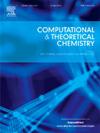Theoretical study on the dissociation of HCl-(H2O)1–30 and HNO3-(H2O)1–30 clusters
IF 3
3区 化学
Q3 CHEMISTRY, PHYSICAL
引用次数: 0
Abstract
HCl-(H2O)n and HNO3-(H2O)n clusters are HCl complexes and HNO3 complexes constituted by small assemblies of n water molecules forming hydrogen bond network with HCl and HNO3, respectively. Herein, a comparative study on HCl-(H2O)n and HNO3-(H2O)n (n ≤ 29) is performed at the B3LYP-D3, ωB97XD, M06-2x, and MP2 levels with the 6–31 + G(d,p) basis set, focusing on hydrogen bonding interactions, relative stabilities, cooperativity energies, NBO charge transfer and vibration of H3O+. The results show that water clusters tend to stabilize more HNO3 than HCl based on computed binding energies and cooperativity energies. At least four and five water molecules are required for a total dissociation of HCl and HNO3, respectively. Comparison between endohedral and exohedral clusters HCl-(H2O)n and HNO3-(H2O)n (n = 19–20, 27–29) shows that chloride and nitrate are more stabilized inside the cage, unlike H3O+ which prefers laying on the cluster surface. The third overtones of O![]() H mode of H3O+ in HCl-water and HNO3-water large clusters are found to be in good agreement with experiments laying around 9000–7700 cm−1.
H mode of H3O+ in HCl-water and HNO3-water large clusters are found to be in good agreement with experiments laying around 9000–7700 cm−1.

HCl-(H2O) 1-30和HNO3-(H2O) 1-30簇解离的理论研究
HCl-(H2O)n和HNO3-(H2O)n簇分别是由n个水分子的小集合与HCl和HNO3形成氢键网络而构成的HCl配合物和HNO3配合物。本文对HCl-(H2O)n和HNO3-(H2O)n (n≤29)在B3LYP-D3、ωB97XD、M06-2x和MP2能级(6-31 + G(d,p)基集上进行了对比研究,重点研究了h30o +的氢键相互作用、相对稳定性、协同能、NBO电荷转移和振动。结果表明,基于结合能和协同能的计算,水团簇对HNO3的稳定性高于HCl。要完全解离HCl和HNO3,至少需要4个和5个水分子。HCl-(H2O)n和HNO3-(H2O)n (n = 19 - 20,27 - 29)在笼内和笼外簇的比较表明,氯化物和硝酸盐在笼内更稳定,而h30o +更倾向于在簇表面。在hcl -水和hno3 -水大团簇中,h30 + OH模式的第三泛音与实验结果一致,分布在9000 ~ 7700 cm−1附近。
本文章由计算机程序翻译,如有差异,请以英文原文为准。
求助全文
约1分钟内获得全文
求助全文
来源期刊

Computational and Theoretical Chemistry
CHEMISTRY, PHYSICAL-
CiteScore
4.20
自引率
10.70%
发文量
331
审稿时长
31 days
期刊介绍:
Computational and Theoretical Chemistry publishes high quality, original reports of significance in computational and theoretical chemistry including those that deal with problems of structure, properties, energetics, weak interactions, reaction mechanisms, catalysis, and reaction rates involving atoms, molecules, clusters, surfaces, and bulk matter.
 求助内容:
求助内容: 应助结果提醒方式:
应助结果提醒方式:


